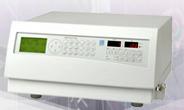|
Instrument Database:
Dionex Corporation - P680A LPG Quaternary Gradient Pump
| |
|

|
| |
|
| |
|
| Year of introduction |
|
| Status |
available |
| Company |
Dionex Corporation
|
| Categories |
Chromatography: LC/HPLC
|
|
Achieve higher productivity using the P680A LPG Low-Pressure Gradient Pump. Its flexible eluent proportioning (four eluents) and synchronization with injection optimizes all routine and method development applications. Get faster results from your HPLC system with the P680A LPG minimal delay volume of less than 400 µL—independent of system backpressure. The built-in vacuum degasser, a costly option in other manufacturers’ pumps, is standard in the LPG version. | | Higher Productivity
The P680A LPG helps you achieve higher productivity in method development applications due to the flexibility of up to four eluents. With programmable rinse cycles, the pump can wash out buffers automatically before shutting down the system, thus preventing blockages of capillaries and tubing. The standard built-in vacuum degasser, a costly option in other manufacturers’ pumps, ensures smooth baselines and trouble-free flow. | Accurate and Precise Gradients
The best way to test the ability of a pump to perform accurate and precise gradients is to run a gradient profile with very small gradient steps. With the P680, the 1% steps are clearly defined, accurate, and reproducible; the maximum step deviation is less than 0.5%. The reproducibility is better than 0.2% SD for all steps. This incredible performance is achieved using SmartFlow TM technology and the high precision of the pump's proportioning valve. | Faster Results with Minimal Delay Volume
Because the P680 pump eliminates pulsation at its source, additional pulse dampening devices are not required. Thus, the gradient delay volume, even for the low-pressure gradient configuration, is less than 400 µL, including the integral dynamic mixing chamber. Unlike pulse damper equipped systems, the delay volume—and therefore the retention time reproducibility in gradient applications—is totally independent of the system pressure. Minimal gradient delay volume and the small-volume dynamic mixer make even fast gradients highly reproducible. | Reliable Results
The synchronization of the ASI-100 TM Autosampler injection with the P680A LPG pump, pushes the retention time reproducibility to new limits. The synchronization is typically used with gradient applications. The autosampler and pump communicate with each other to ensure reliable results for your most demanding analysis. |
|
| Specifications |
|
| | | P680A LPG Quaternary Gradient Pump Specifications | | Flow rate range | 1–10,000 µL/min | | Flow rate accuracy and reproducibility | ±0.1% at 1 mL/min | | Gradient formation | Quaternary (from up to four eluents) | | Pressure range | 0.1–50 MPa (7250 psi) | | Pressure ripple | Typically <1% | | Proportioning accuracy | ±0.5% at 2 mL/min | | Proportioning reproducibility | ±0.5% at 2 mL/min | | Number of solvents | Four | | Gradient delay volume (standard pump) | <400 µL | | Solvent degassing | Built-in four-channel vacuum degasser | | Remote control | All functions controllable through LAN or USB
Permanent status transfer
Program-controlled or stand-alone operation | | I/O interfaces | Three digital inputs for Start, Stop, and Hold
Four programmable relays
Motorized switching-valve port
Analog output for system pressure | | PC connection | USB or TCP/IP (RJ-45) | | Additional communication ports | RS-232 port for connection of an ASI-100TM Autosampler or STH-585 Column Thermostat | | Additional USB ports | Integrated USB hub with three type A USB ports for connection of other Summit HPLC modules | | Safety features | Minimum/maximum pressure shutdown (selectable)
Time monitoring of pump functions
Leak sensors | | User input/display | Keypad (solvent-resistant)
Eight-line LCD (21 characters per line)
11 LEDs
User input is possible while a program is active | | Wetted parts | Stainless steel (1.4571), sapphire, ruby, ceramics, UHMW polyethylene, PCTFE, PTFE, PEEK, zirconimum oxide (ZrO2), aluminium oxide (Al2O3) | | Power requirements | Max. 80 W (100–120 V, 60 Hz; 200–240 V, 50 Hz) | | Operating conditions | Temperature: 10–35 °C (50–95° F)
Air humidity: 40–85% relative humidity, noncondensing
Overvoltage category: II
Pollution degree: 2 | | Dimensions (h × w × d) | 19 × 40 × 38 cm (7.5 × 15.8 × 15.0 in.) | | Weight | 15.8 kg (34.8 lb) |
|
|
|